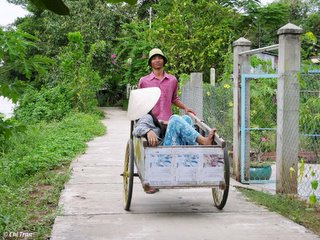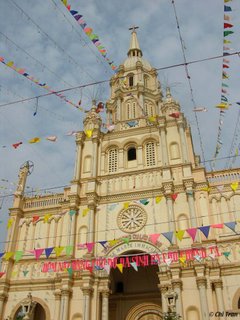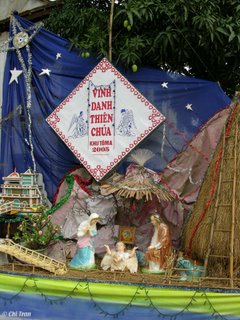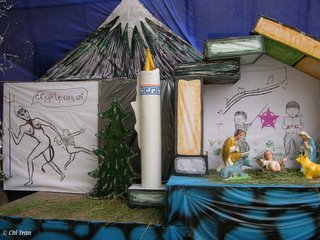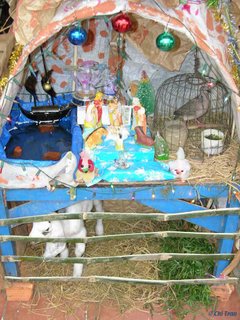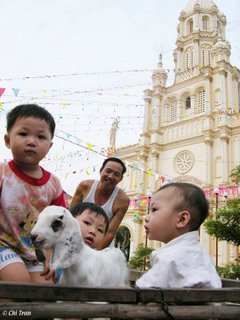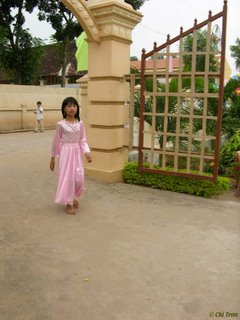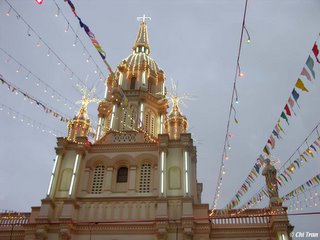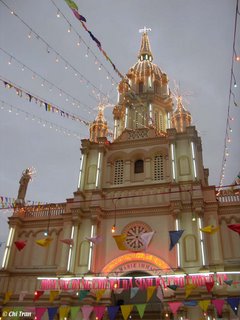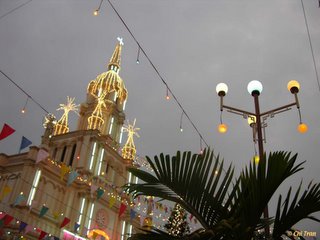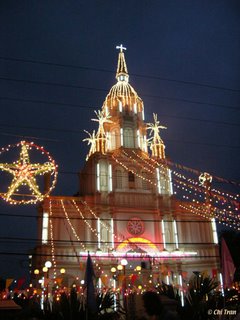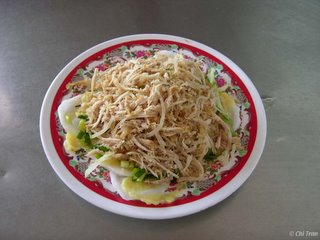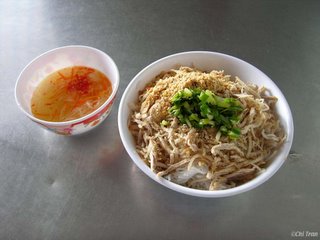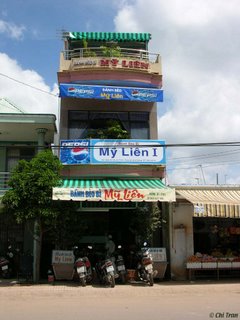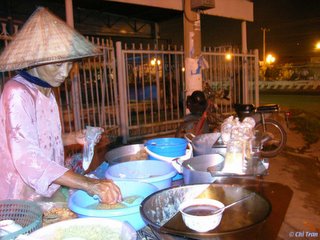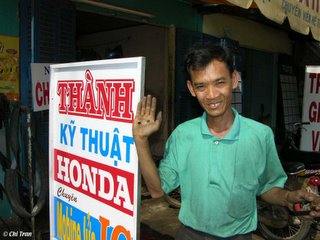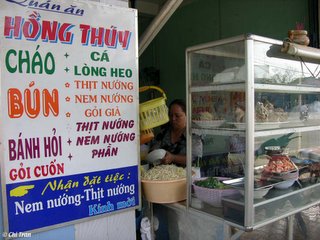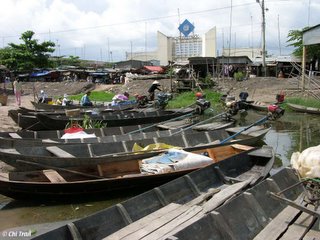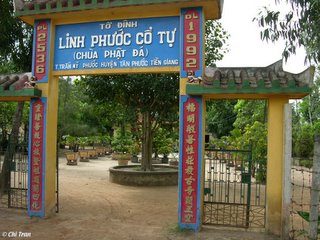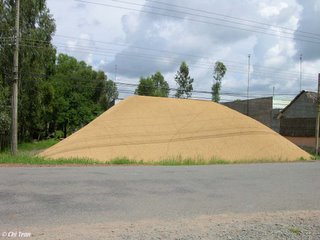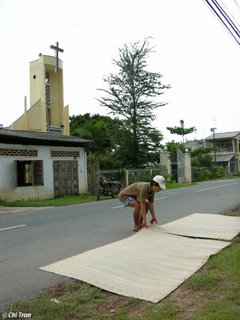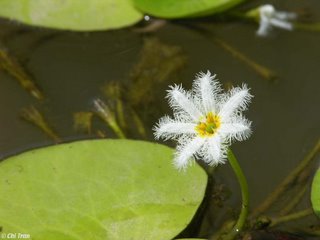
To me, this aqua flower is a symbol of the annual flood, it looks so beautiful under the bright sun when the flood is settled, its name is Tra`ng.

This is a wild water lily, its petals are always white, I just love its warm and sincere scent.
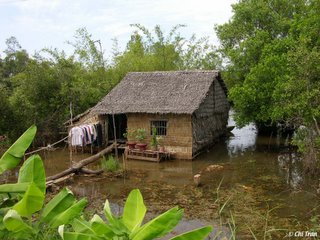
This house is flood ready all the way. Notice the canoe moored in the back.

People live peacefully with the flood, either wading in water or using canoe to haul things to and from the market.
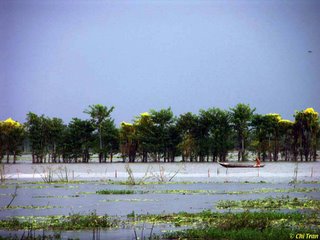
The row of flooded 'gao' trees is partly covered at the top by the yellow 'to hong' (cupid) vines. It took me quite sometime to get to this location and by the time my canoe reached the good shooting spot, the stormy rain started falling. I had only seconds to hurry my shots and ordered my rowers to quickly find a safe shelter as thundering lightnings tore the dark sky. Days ago, a couple were struck by lightning only a few kilometers away, the husband and his wife were charred with the portable radio held by the woman turned into a black metal cube.
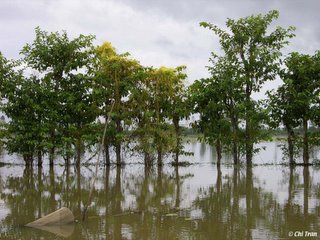
A few weeks later, I returned and moved closer to the vines to take a better shot of this romantic vegetation. First, there was a soft look.
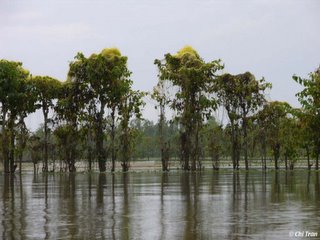
Then there was this kind of eerie landscape.

The water is about one and a half meter high. Hut houses built on the rice paddy border are now covered with climbing vines as the tenants no longer live there during the flood season.
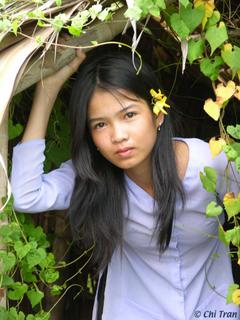
It's not common place, but sometimes one can find such a beauty like this young girl deep in the countryside. She wears 'dien dien' flower in her hair. This kind of edible flower, very good for fish sour soup indeed, grows wild everywhere during the flood season. I love to eat them too.

Not only the empty canoe, floated still on the flooded front yard, illustrates vividly the flood situation, the drinking cat makes this picture a charming winner.
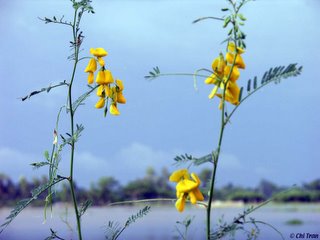
Ubiquitous dien dien flowers bloom during the flood season.
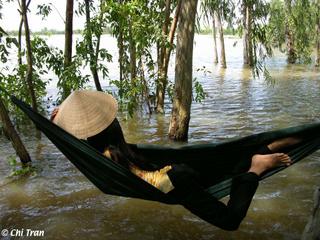
My romantic way of looking at the flood.
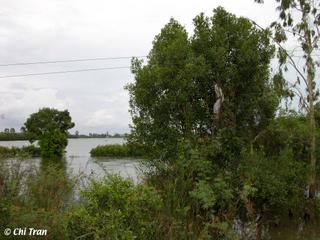
'Ca` na' trees grow wild along the canal banks in Dong Thap Muoi swamp. They only give abundant fruits during the flood season.

Kids love to pick them, especially girls.

Eaten these fruits with salt makes a very good snack in between meals.
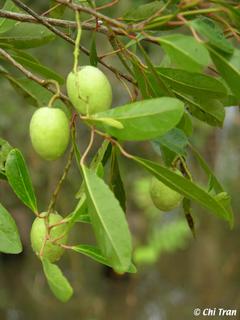
These 'ca` na' fruits taste similar to olives. If rightfully pickled, they can rival their western counterparts. Used to be processed by the Chinese to make a delicious snack, now the recipe seems to be lost forever after years of war upheaval.
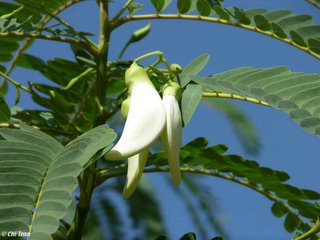
Toward the end of the rainy season around early November, this kind of flower called 'sua dua' starts to bloom. These are edible flowers, they make delicious soup ingredients especially when cooked with fish. Not like their 'dien dien' counterparts, which grow wild, these sua dua flowers (also called so dua) come from the planted trees of the same name.

For some reason unknown to me, people outside of the Mekong Delta don't eat these flowers, they just leave them faded and fallen to the ground. On my rides through those areas, I could pick as much as I wanted then stopped at a roadside restaurant, ordered a fish pot soup and have myself a wonderful time enjoying the edible flowers.

Starting as of end 2004 last year, this variety of red sua dua flower and tree appear here and there in the Mekong Delta. Now in 2005, it is a little more widely planted. To me, it tastes the same as the white variety although its red color turned dark purple when cooked might give you a quasi different taste. On my trip, these flowers were thoroughfully cleansed by a big rain, thus provided me with an excellent pot soup cooked with Viet basa fish.
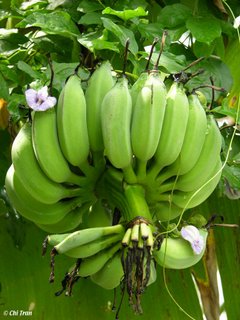
Naturally decorated green bananas after a flash rain.
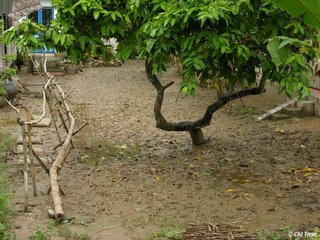
The flood doesn't come and go evenly among the Mekong provinces. The Dong Thap Muoi swamp bears the largest and longest flow. When the flood recedes, it looks mostly like this.
 To me, this aqua flower is a symbol of the annual flood, it looks so beautiful under the bright sun when the flood is settled, its name is Tra`ng.
To me, this aqua flower is a symbol of the annual flood, it looks so beautiful under the bright sun when the flood is settled, its name is Tra`ng. This is a wild water lily, its petals are always white, I just love its warm and sincere scent.
This is a wild water lily, its petals are always white, I just love its warm and sincere scent. This house is flood ready all the way. Notice the canoe moored in the back.
This house is flood ready all the way. Notice the canoe moored in the back. People live peacefully with the flood, either wading in water or using canoe to haul things to and from the market.
People live peacefully with the flood, either wading in water or using canoe to haul things to and from the market. The row of flooded 'gao' trees is partly covered at the top by the yellow 'to hong' (cupid) vines. It took me quite sometime to get to this location and by the time my canoe reached the good shooting spot, the stormy rain started falling. I had only seconds to hurry my shots and ordered my rowers to quickly find a safe shelter as thundering lightnings tore the dark sky. Days ago, a couple were struck by lightning only a few kilometers away, the husband and his wife were charred with the portable radio held by the woman turned into a black metal cube.
The row of flooded 'gao' trees is partly covered at the top by the yellow 'to hong' (cupid) vines. It took me quite sometime to get to this location and by the time my canoe reached the good shooting spot, the stormy rain started falling. I had only seconds to hurry my shots and ordered my rowers to quickly find a safe shelter as thundering lightnings tore the dark sky. Days ago, a couple were struck by lightning only a few kilometers away, the husband and his wife were charred with the portable radio held by the woman turned into a black metal cube. A few weeks later, I returned and moved closer to the vines to take a better shot of this romantic vegetation. First, there was a soft look.
A few weeks later, I returned and moved closer to the vines to take a better shot of this romantic vegetation. First, there was a soft look. Then there was this kind of eerie landscape.
Then there was this kind of eerie landscape. The water is about one and a half meter high. Hut houses built on the rice paddy border are now covered with climbing vines as the tenants no longer live there during the flood season.
The water is about one and a half meter high. Hut houses built on the rice paddy border are now covered with climbing vines as the tenants no longer live there during the flood season. It's not common place, but sometimes one can find such a beauty like this young girl deep in the countryside. She wears 'dien dien' flower in her hair. This kind of edible flower, very good for fish sour soup indeed, grows wild everywhere during the flood season. I love to eat them too.
It's not common place, but sometimes one can find such a beauty like this young girl deep in the countryside. She wears 'dien dien' flower in her hair. This kind of edible flower, very good for fish sour soup indeed, grows wild everywhere during the flood season. I love to eat them too. Not only the empty canoe, floated still on the flooded front yard, illustrates vividly the flood situation, the drinking cat makes this picture a charming winner.
Not only the empty canoe, floated still on the flooded front yard, illustrates vividly the flood situation, the drinking cat makes this picture a charming winner. Ubiquitous dien dien flowers bloom during the flood season.
Ubiquitous dien dien flowers bloom during the flood season. My romantic way of looking at the flood.
My romantic way of looking at the flood. 'Ca` na' trees grow wild along the canal banks in Dong Thap Muoi swamp. They only give abundant fruits during the flood season.
'Ca` na' trees grow wild along the canal banks in Dong Thap Muoi swamp. They only give abundant fruits during the flood season. Kids love to pick them, especially girls.
Kids love to pick them, especially girls. Eaten these fruits with salt makes a very good snack in between meals.
Eaten these fruits with salt makes a very good snack in between meals. These 'ca` na' fruits taste similar to olives. If rightfully pickled, they can rival their western counterparts. Used to be processed by the Chinese to make a delicious snack, now the recipe seems to be lost forever after years of war upheaval.
These 'ca` na' fruits taste similar to olives. If rightfully pickled, they can rival their western counterparts. Used to be processed by the Chinese to make a delicious snack, now the recipe seems to be lost forever after years of war upheaval. Toward the end of the rainy season around early November, this kind of flower called 'sua dua' starts to bloom. These are edible flowers, they make delicious soup ingredients especially when cooked with fish. Not like their 'dien dien' counterparts, which grow wild, these sua dua flowers (also called so dua) come from the planted trees of the same name.
Toward the end of the rainy season around early November, this kind of flower called 'sua dua' starts to bloom. These are edible flowers, they make delicious soup ingredients especially when cooked with fish. Not like their 'dien dien' counterparts, which grow wild, these sua dua flowers (also called so dua) come from the planted trees of the same name. For some reason unknown to me, people outside of the Mekong Delta don't eat these flowers, they just leave them faded and fallen to the ground. On my rides through those areas, I could pick as much as I wanted then stopped at a roadside restaurant, ordered a fish pot soup and have myself a wonderful time enjoying the edible flowers.
For some reason unknown to me, people outside of the Mekong Delta don't eat these flowers, they just leave them faded and fallen to the ground. On my rides through those areas, I could pick as much as I wanted then stopped at a roadside restaurant, ordered a fish pot soup and have myself a wonderful time enjoying the edible flowers. Starting as of end 2004 last year, this variety of red sua dua flower and tree appear here and there in the Mekong Delta. Now in 2005, it is a little more widely planted. To me, it tastes the same as the white variety although its red color turned dark purple when cooked might give you a quasi different taste. On my trip, these flowers were thoroughfully cleansed by a big rain, thus provided me with an excellent pot soup cooked with Viet basa fish.
Starting as of end 2004 last year, this variety of red sua dua flower and tree appear here and there in the Mekong Delta. Now in 2005, it is a little more widely planted. To me, it tastes the same as the white variety although its red color turned dark purple when cooked might give you a quasi different taste. On my trip, these flowers were thoroughfully cleansed by a big rain, thus provided me with an excellent pot soup cooked with Viet basa fish. Naturally decorated green bananas after a flash rain.
Naturally decorated green bananas after a flash rain. The flood doesn't come and go evenly among the Mekong provinces. The Dong Thap Muoi swamp bears the largest and longest flow. When the flood recedes, it looks mostly like this.
The flood doesn't come and go evenly among the Mekong provinces. The Dong Thap Muoi swamp bears the largest and longest flow. When the flood recedes, it looks mostly like this.
